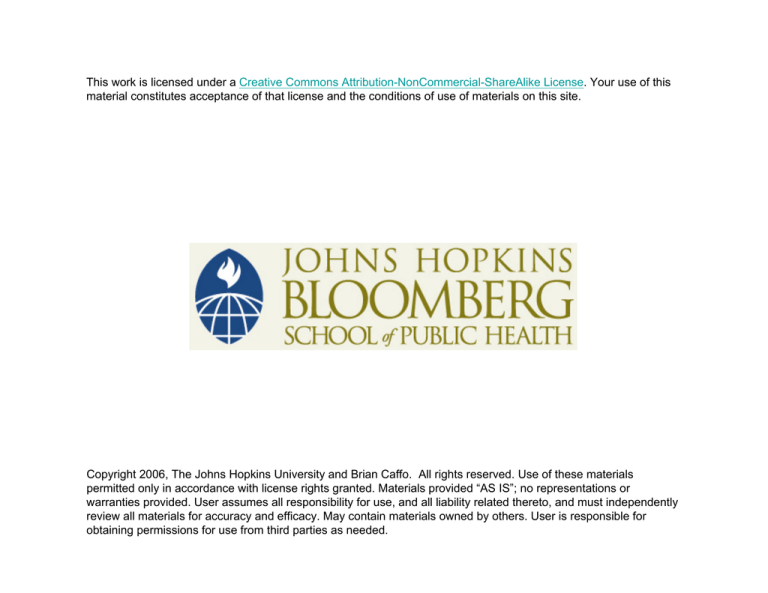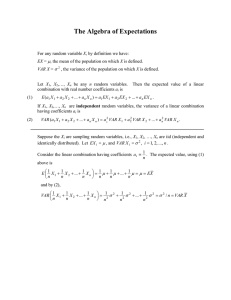
This work is licensed under a Creative Commons Attribution-NonCommercial-ShareAlike License. Your use of this
material constitutes acceptance of that license and the conditions of use of materials on this site.
Copyright 2006, The Johns Hopkins University and Brian Caffo. All rights reserved. Use of these materials
permitted only in accordance with license rights granted. Materials provided “AS IS”; no representations or
warranties provided. User assumes all responsibility for use, and all liability related thereto, and must independently
review all materials for accuracy and efficacy. May contain materials owned by others. User is responsible for
obtaining permissions for use from third parties as needed.
Outline
1. Define random vectors
2. Independent events and variables
3. IID random variables
4. Covariance and correlation
5. Standard error of the mean
6. Unbiasedness of the sample variance
Random vectors
• Random vectors are simply random variables collected
into a vector
◮ For
example if X and Y are random variables (X, Y )
is a random vector
• Joint
• For
density f (x, y) satisfies f > 0 and
discrete random variables
PP
RR
f (x, y)dxdy = 1
f (x, y) = 1
• In this lecture we focus on independent random vari-
ables where f (x, y) = f (x)g(y)
Independent events
• Two
events A and B are independent if
P (A ∩ B) = P (A)P (B)
• Two
random variables, X and Y are indepdent if for
any two sets A and B
P ([X ∈ A] ∩ [Y ∈ B]) = P (X ∈ A)P (Y ∈ B)
• If A
Ac
is independent of B then
is independent of B
A is independent of B c
Ac is independent of B c
Example
What is the probabilty of getting two consecutive heads?
A = {Head
on flip 1} P (A) = .5
B = {Head
on flip 2} P (B) = .5
A ∩ B = {Head
on flips 1 and 2}
P (A ∩ B) = P (A)P (B) = .5 × .5 = .25
Useful fact
We will use the following fact extensively in this class:
If a collection of random variables X1, X2, . . . , Xn are
independent, then their joint distribution is the product of their individual densities or mass functions.
That is, if fi is the density for random variable Xi
we have that
f (x1, . . . , xn) =
n
Y
i=1
fi(xi).
IID random variables
• In
the instance where f1 = f2 = . . . = fn we say that the
Xi are iid for independent and identically distributed.
• iid
random variables are the default model for random samples
• Many of the important theories of statistics are founded
on assuming that variables are iid
Example
Suppose that we flip a biased coin with success probability p n times, what is the join density of the collection
of outcomes?
These random variables are iid with densities pxi (1−p)1−xi
f (x1, . . . , xn) =
n
Y
i=1
pxi (1 − p)1−xi = p
P
P
xi (1 − p)n− xi
Correlation
The covariance between two random variables X and
Y is defined as
Cov(X, Y ) = E[(X − µx)(y − µy )] = E[XY ] − E[X]E[Y ].
The following are useful facts about covariance.
i. Cov(X, Y ) = Cov(Y, X).
ii. Cov(X, Y ) can be negative or positive.
p
iii. |Cov(X, Y )| ≤ Var(X)Var(y)
Correlation
The correlation between X and Y is
p
Cor(X, Y ) = Cov(X, Y )/ Var(X)Var(y).
i. −1 ≤ Cor(X, Y ) ≤ 1.
ii. Cor(X, Y ) = ±1 if and only if X = a + bY for some constants a and b.
iii. Cor(X, Y ) is unitless.
iv. X and Y are uncorrelated if Cor(X, Y ) = 0.
v. X and Y are more positively correlated, the closer
Cor(X, Y ) is to 1.
vi. X and Y are more negatively correlated, the closer
Cor(X, Y ) is to −1.
Some useful results
Let {Xi}ni=1 be a collection of random variables
• When
the {Xi} are uncorrelated
Var
n
X
i=1
aiXi + b =
n
X
a2i Var(Xi)
i=1
• Otherwise
n
n
n
n−1
X
X
XX
Var
aiXi + b =
a2i Var(Xi) + 2
aiaj Cov(Xi, Xj ).
i=1
i=1
i=1 j=i
• If the Xi are iid with variance σ 2 then Var(X̄) = σ 2/n and
E[S 2] = σ 2
Example proof
Prove that Var(X + Y ) = Var(X) + Var(Y ) + 2Cov(X, Y )
Var(X + Y ) = E[(X + Y )(X + Y )] − E[X + Y ]2
= E[X 2 + 2XY + Y 2] − (µx + µy )2
= E[X 2 + 2XY + Y 2] − µ2x − 2µxµy − µ2y
= (E[X 2] − µ2x) + (E[Y 2] − µ2y ) + 2(E[XY ] − µxµy )
= Var(X) + Var(Y ) + 2Cov(X, Y )
The sample mean
Suppose Xi are iid with variance σ2
Var(X̄) = Var
n
X
1
Xi
n
i=1
n
X
1
= 2 Var
Xi
n
i=1
n
1 X
= 2
Var(Xi)
n
i=1
1
= 2 × nσ 2
n
σ2
=
n
Some comments
• When Xi
are independent with a common variance
2
σ
Var(X̄) = n
√
• σ/ n is called the standard error of the sample mean
• The
standard error of the sample mean is the standard deviation of the distribution of the sample mean
is the standard deviation of the distribution of a
single observation
•σ
• Easy
way to remember, the sample mean has to be
less variable than a single observation, therefore its
√
standard deviation is divided by a n
The sample variance
• The
sample variance is defined as
S2 =
• The
Pn
2
(X
−
X̄)
i=1 i
n−1
sample variance is an estimator of σ2
• The
numerator has a version that’s quicker for calculation
n
n
X
i=1
(Xi − X̄)2 =
X
i=1
Xi2 − nX̄ 2
• The sample variance is (nearly) the mean of the squared
deviations from the mean
The sample variance is unbiased
n
n
h i
h i
X
X
E (Xi − X̄)2 =
E Xi2 − nE X̄ 2
i=1
=
=
i=1
n n
X
n
o
Var(Xi) + µ2 − n Var(X̄) + µ2
i=1
n n
X
i=1
o
o
n
o
σ 2 + µ2 − n σ 2/n + µ2
= nσ 2 + nµ2 − σ 2 − nµ2
= (n − 1)σ 2
Hoping to avoid some confusion
• Suppose Xi
• S2
are iid with mean µ and variance σ2
estimates σ2
• The calculation of S 2 involves dividing by n − 1
√
√
• S/ n estimates σ/ n the standard error of the mean
√
• S/ n is called the sample standard error (of the mean)
Example
• In
a study of 495 organo-lead workers, the following
summaries were obtained for TBV in cm3
• mean
• sum
= 1151.281
of squared observations = 662361978
• sample
sd =
• estimated
se
p
(662361978 − 495 × 1151.2812)/494 = 112.6215
√
of the mean = 1151.281/ 495 = 5.062








